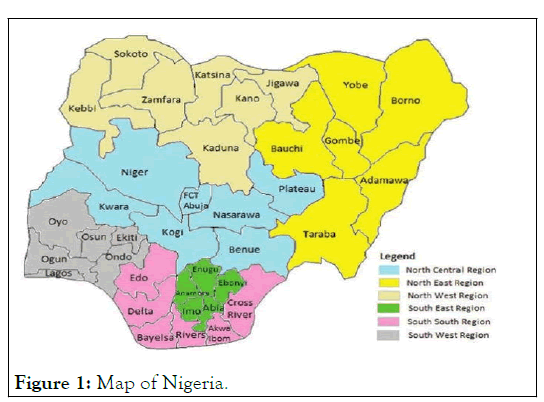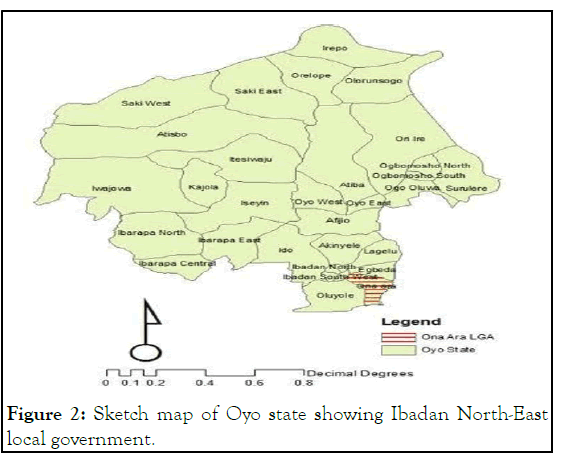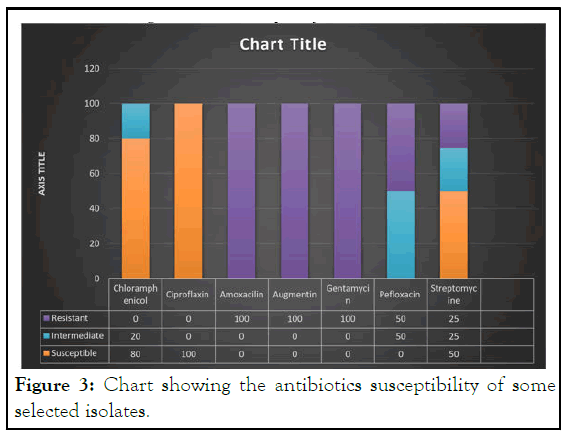Journal of Infectious Diseases & Preventive Medicine
Open Access
ISSN: 2329-8731
+44 1300 500008
ISSN: 2329-8731
+44 1300 500008
Research Article - (2023)Volume 11, Issue 2
The survey was conducted to evaluate the bacterial isolates recovered from the drinking water sources obtained from Temidire, Oje area, Idi-Agbon/Beere area and OdoOsun area in Ibadan North-East local government area, Oyo State, Nigeria.
Ethical permissions were obtained, research questionnaires were administered to the residents of the study areas and sixteen water samples obtained from the areas were used for the analysis. Laboratory results were appropriately analyzed using conventional methods of isolating both Enterobacteriaceae and the other gram positive organisms as basis for generating inferences in the study.
All the examined water samples collected from the study areas were contaminated with at least one bacteria species and twelve (12) bacteria species were recovered from the samples, Salmonella typhi (20.4%) were the most frequent isolates followed by Staphylococcus aureus (14.0%), Escherichia coli (12.9%), Shigella dysenteriae (11.8%), Klebsiella pneumonia (8.6%), Proteus mirabilis (7.5%), Serratia marcescens (5.4%), Enterobacter aerogenes (5.4%), Shigella flexneri (4.3%), Staphylococcus epidermidis (4.3%), Pseudomonas aeruginosa (3.2%) while Vibrio cholerae were the least frequent bacteria isolates.
Unhygienic practices, inadequate education and knowledge about water safety issues were responsible for water borne diseases. Water safety education of the target population and enforcement of existing laws on environmental sanitation and hygiene as a basic preventive strategy is hereby recommended.
Bacteria isolates; Infections; Antibiotic resistant; Water; Antibiotics
Water is an essential part of human nutrition either directly as drinking water or indirectly as constituent of food and served in various other applications of our daily life. Good drinking water is of basic importance to human physiology and the continued existence of man depends on its availability [1-3]. The human body is made up of 70% water and people begin to feel thirsty after a loss of only 1% of the body fluid and risk death if the loss nears 10%. Unfortunately, clean, pure and safe water only exists briefly in nature and is immediately polluted by prevailing environmental factors and human activities. Water from most sources is unfit for immediate consumption without some sort of treatment. In addition, the rapid growth of industrialization, urbanization and increase in human population around the globe has led to high demand for good quality water; for domestic, recreational, industrial activities and other purposes have continuously threatened the value of this resource [4-6].
The potability of drinking water across the globe has increasingly continued to be in doubt, due to the problem of microbial contamination, high saline content and external human activity stress, thus making the water quality questionable and no longer guaranteed as safe for human consumption. The provision of potable water to rural and urban population is necessary to prevent health hazards. Before water can be described as potable, it has to comply with certain physical, chemical and microbiological standards, which are designed to ensure that the water is palatable and safe for drinking. Potable water is defined as water that is free from disease-producing microorganisms and chemical substances deleterious to health.
Water is obtained from a number of sources in nature which can be classified as either from the periphery (surface water e.g. streams, lakes, rivers, ponds, springs) or from the underneath (ground water e.g. boreholes and wells). Globally, ground water is the largest and most important source of potable water [7-11].
According to the department of international development strategies for achieving the international development targets, an estimate of 1.5 billion people has ground water as their daily potable water source for meeting rural water demand in the sub- Saharan Africa. However, the vast majority of people living in developing countries still rely on surface waters as their primary sources of water and simultaneously, as their means of waste disposal. A large percentage of the population in African countries especially lack access to potable water supply, thus, they are compelled to use untreated water from other sources such as rivers, reservoirs, springs, streams and groundwater for drinking and domestic purposes which can cause the outbreaks of waterborne diseases.
Poor quality of drinking water has contributed to the increase in morbidity, due to water borne diseases (diarrhea, cholera, dysentery, typhoid etc.), especially in children (infant diarrhea is considered one of the foremost causes of disease and death in children worldwide) and immunocompromised individuals, thereby, increasing the burden of diseases. Water borne disease is a huge concern and a major public health problem, because it affects the health of an individual in most cases, when it is ingested into the body via fecal-oral route, therefore; the need for the evaluation of the microbial contamination of water remains paramount and thoughtful towards the good health and safety of all.
In this study, we carried out an epidemiological survey of bacterial isolates from drinking water samples in Ibadan northeast local government area, Oyo state, Nigeria.
The epidemiology studies were conducted in Ibadan North-East local government area, Oyo state between June 2021-October 2021 (Figures 1 and 2).

Figure 1: Map of Nigeria.

Figure 2: Sketch map of Oyo state showing Ibadan North-East local government.
Sixteen (16) Water samples were collected from drinking water sources at three different areas located Ibadan North local government area of Oyo state. The locations of the water source include:
• Temidire, Oje Area (T)
• Idi-Agbon/Beere Area (ID)
• Odo-Osun Area (OD)
The sample codes and the sources include:
• T1-Well water
• T2-Borehole
• T3-Borehole
• T4-Well water
• T5-Well water
• T6-Borehole
• T7-Well water
• ID1-Well water
• ID2-Well water
• ID3-Well water
• ID4-Sachet water
• OD1-Borehole
• OD2-Well water
• OD3-Well water
• OD4-Borehole
• OD5-Sachet water
Inoculation of samples
Seventeen samples were inoculated into petri dishes using the pour plate method. Out of the seventeen samples, ten samples were serially diluted in ten-folds to reduce the bacterial load of the samples. Distinct isolates from the nutrient agar plates were sub cultured into a fresh nutrient agar plate to obtain a pure isolate, which are transferred into various selective and differential agar to test for the presence of specific microorganisms. The isolates obtained from the nutrient agar were transferred into Mannitol salt agar (to screen for bacteria belonging to Staphylococci), MacConkey agar, Eosin Methylene Blue (EMB) Agar and Salmonella-Shigella agar respectively to screen for bacteria belonging to Enterobacteriaceae. Gram staining, morphological identification, catalase and coagulase tests, sugar fermentation analysis and antimicrobial susceptibility trends of the isolate were conducted.
A total of sixteen samples from different drinking water sources in the study area were collected. Water samples were inoculated on various differential and selective agars (Supplementary Tables 1-6). Ninety three isolates obtained were microscopically examined and the physical properties are stated below (Figure 3).

Figure 3: Chart showing the antibiotics susceptibility of some selected isolates.
This research has revealed the presence of heterotrophic bacteria and coliform bacteria in the various drinking water samples collected from the three study sites in Ibadan North-East local government area of Oyo state. Water suitable for human consumption (potable water) should be free from disease causing organisms, as well as large numbers of nonpathogenic organisms. The water from one location (Idi Agbon/Beere Area) had considerable lower bacterial counts but high total coliform counts and could be concluded to be of bad quality for domestic use, while samples from Temidire, Oje Area and Odo Osun area, had much higher counts of bacteria isolates with low coliform count and could also be concluded that the water samples are not hygienic for consumption.
Therefore, it can be concluded that water from all the sources investigated are not suitable for drinking without treatment process to kill or inactivate the pathogens. WHO (World Health Organization) and united state environmental protection agency standard for faecal coliform in drinking water is zero coliform. As a result, water from all the various sources should be properly treated before use to avoid the potential outbreak of water borne epidemic.
The presence of high coliform count reported in some of the water sources in this study could probably be attributed to the proximity of the well and boreholes to septic tanks and the general unhygienic and poor sanitary environment surrounding the water sources, this agrees with the study carried out by Bello et al. in 2013. Moreover, shallow depth of less than 40 m for boreholes could be the problem because it contradicts the 40 m minimum depth recommendation. Depth is an issue as reported in previous studies by Seth, et al. in 2014 and Thivya, et al. in 2014. Although the depths of the various boreholes studied were unknown, borehole depth is an imperative factor in the investigation of bacterial contaminants in borehole water.
Furthermore, it could probably be that the pipes used for water distribution of the borehole and the rings around the well were bad thus, allowing seepage of microbial contaminants into the boreholes and wells respectively, it is strongly suggested that damaged pipes allow leakage causing contamination of microbial pathogens into the body of aquifer as seen in this study and a previous study by Ibe et al., in 2002 reported same trend as a major factor to be considered when planning for potable water safety. These and other human activities could have probably contributed to the water contamination as revealed in other studies by Govindarajan and Senthilnathan, in 2014 and Moyo in 2013.
Samples from the well water in Temidire, Oje area (T1) had the highest bacterial count whereas, samples from the well water in Idi-Agbon/Beere area (ID1) had the lowest bacterial count from the nine well water sampled in the study sites. Similarly, samples from the boreholes in both Temidire, Oje area and Odo-Osun area (T6 and OD1) had the highest bacterial count while samples from the boreholes in Temidire, Oje area (T2 and T3) had the lowest bacterial count for samples collected in the study sites (Table 1).
Furthermore, samples collected from Idi-Agbon/Beere area had the highest coliform counts and Odo-Osun Area had the lowest coliform count. The result from this study shows that water sampled from the sources in Temidire, Oje area had the highest bacterial count in this study meaning the microbial contamination in these water sources is much as compared to that in the other sites as contained in this study. This agrees with the work of Sylvester and Ebinyo., in 2015 which reviewed the microbial quality of potable water sources and reported the presence of microbial contaminants in drinking water in Nigeria; also, according to the epidemiological survey by the Federal ministry of health of Nigeria. Similarly, Nwinyi et al., in 2020, reported microbial contamination in drinking water, which leads to water borne diseases by reviewing the drinking water quality in Nigeria towards attaining the sustainable development goal six. Since the water quality varies both temporally and spatially, occasional sampling may not accurately reflect actual exposure. Moreover, source indicator i.e. sanitary inspection (hazards identification and hygienic checks) of both the water and its surrounding is a complementary approach in the assessment of safe drinking water in a cosmopolitan society like the study sites with massive anthropogenic activities.
Water sources for human consumption is supposed to be free from objectionable (color, taste, turbidity) and microbial contaminants. In Nigeria, potable water sources are met by surface (river, stream, and spring), ground water (borehole, well) and to lesser extent rainwater. Borehole water is usually packaged into bottle and sachet for sale. The microbial density of various potable water sources in Nigeria often exceed the World Health Organization/Food and agricultural organization allowable limit of 1.0 × 102 cfu/ml for potable water and standard organization of Nigeria maximum permissible level of 10 cfu/ml (total coliform) and 0 cfu/100 ml (Thermo tolerant Coliform or Escherichia coli, Faecal Streptococcus and Clostridium perfringens spore). Typically, microbial load of the different potable water sources in the order surface water (River, stream)>ground water (well and borehole). However, microbial density were least in packaged sachet water.
Several dominant microbial diversity found in the potable water sources including Staphylococcus aureus, Escherichia coli, Proteus spp., Pseudomonas, Enterobacter, Salmonella, Klebsiella, Serratia spp. etc., are known to cause disease conditions. To reduce the incident of microbial water borne diseases in these study areas and Nigeria at large, the drinking water should be adequately treated before consumption. In addition, strategic monitoring and surveillance approach should be encouraged to ensure compliance by water vendors. Infect
[Crossref] [Google Scholar] [PubMed]
Citation: Omololu-Aso J, Fawole A, Omololu-Aso OO, Adesunloro O, Azeez K (2023) Epidemiological Survey of Bacterial Isolates from Drinking Water Samples in Ibadan North-East Local Government Area, Oyo State, Nigeria. Infect Dis Preve Med. 11:287.
Received: 27-Sep-2022, Manuscript No. JADPR-22-19374; Editor assigned: 29-Sep-2022, Pre QC No. JADPR-22-19374 (PQ); Reviewed: 13-Oct-2022, QC No. JADPR-22-19374; Revised: 02-Feb-2023, Manuscript No. JADPR-22-19374 (R); Published: 10-Feb-2023 , DOI: 10.35248/2329-8731.23.11.287
Copyright: © 2023 Omololu-Aso J, et al. This is an open-access article distributed under the terms of the Creative Commons Attribution License, which permits unrestricted use, distribution, and reproduction in any medium, provided the original author and source are credited.